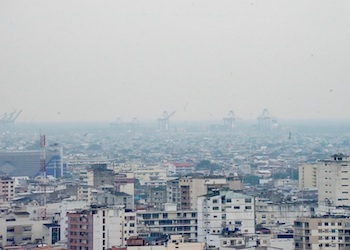Ecuador is one of the region’s most significant drug trafficking hubs, used to dispatch Colombian and Peruvian cocaine to Europe, Mexico, and Central America. It has long been the site of operations for Mexican, Colombian, and European drug trafficking organizations, and Colombian guerrilla groups in its northern border region. In recent years, these international groups and their local proxies have been joined by a new generation of criminal groups known in Ecuador as the “mafias,” which took over the prison system while building up gang networks on the streets. All of these criminal networks have benefited from rampant corruption that has contaminated security, justice, government institutions, and the country’s politics.
Special Series: Behind Bars, Beyond Control: The Fall of Ecuador’s Prisons and the Rise of Its Mafias
Explore our latest investigation into how a crisis in Ecuador’s prisons descended into brutal violence, criminal chaos and a national security crisis.
While long regarded as an island of relative peace despite its importance to organized crime, the emergence of the prison mafias has destabilized the country, as the prisons descended into brutal violence, murder rates reached among the highest in the region, and the country’s institutions were shaken by political violence and top-level corruption scandals.
Geography
Ecuador, one of South America’s smallest countries, borders the two largest cocaine producers in the world: Colombia to the north and Peru to the east and south. This, combined with its extensive western coastline along the Pacific Ocean, has made it one of the primary dispatch points for the global cocaine trade. In particular, the country’s port city of Guayaquil has become a crucial transshipment point for drugs heading to Europe, while the coastal provinces of Manabí and Esmeraldas are major trafficking corridors used to reach Mexican and Central America. As one of the most biodiverse countries in the world, Ecuador is susceptible to an assortment of environmental crimes like illegal fishing. The illicit trade of shark fins in the Galápagos Islands is a particular problem. In addition, there is rampant wildlife trafficking in the country’s eastern Amazon basin, and the vast forests along Ecuador’s borders with Peru and Colombia have been decimated in recent years, partly due to illegal logging. Furthermore, in the mountains of the north and far-flung Amazonian provinces in the east, illegal mining has proliferated at an alarming rate.
History
Ecuador became an independent country in 1830. Its first century was marked by turmoil fueled by internal conflict among elite factions.
In the post-World War II period, Ecuador alternated between periods of constitutional governance and military rule until 1979, when the military ceded power to an elected president for the last time.
Transnational organized crime began establishing a foothold in the country during the latter half of the 20th century. From the 1970s to the 1990s, Colombia’s Medellín and Cali cartels used Ecuador as a transshipment point for trafficking drugs and as a smuggling hub for precursor chemicals needed to process coca leaf into cocaine.
In the 1990s, the now-demobilized guerrillas of the Revolutionary Armed Forces of Colombia (Fuerzas Armadas Revolucionarias de Colombia – FARC) began crossing into the country in search of supplies and safe haven. They would go on to establish a permanent presence in the border region, maintaining camps, controlling drug trafficking routes and processing laboratories, and establishing support networks and supply lines in the cities. The presence of the insurgents drew the attention of their enemies – right-wing Colombian paramilitary groups – and their conflict spilled over the border.
In the early 2000s, Ecuador also experienced an increase in the presence of street gangs and violence. This led the government to take the unprecedented step of legalizing gangs that participated in a “pacification process”, recognizing groups like the Latin Kings as “urban youth groups.” As a result, the homicide rate in Ecuador dropped drastically.
Despite Ecuador’s efforts to deal with internal criminal groups, in the late 2000s, international drug trafficking networks from Colombia and Mexico increased their presence in the country. As the European drug market boomed, they were soon joined by European traffickers, above all Albanian nationals who sent emissaries. Mexican drug trafficking organizations sourcing cocaine in Colombia also used Ecuadorian gangs and drug traffickers as intermediaries and providers of logistical and security services. In the 2010s, the most prominent international networks began to withdraw from the country after being debilitated by international law enforcement efforts. This led to a new generation of homegrown drug traffickers to fill the vacuum.
In the late 2010s, disparate gangs and criminal networks began uniting within the prisons to form powerful mafias that took over the penitentiary system, expanded across the country, and established themselves as key service providers to drug traffickers. The breakup of the most powerful of these groups, the Choneros, in 2021 created an array of splinter groups that violently contested control of the prisons, the streets, and drug trafficking corridors.
These disputes led to a period of unprecedented criminal violence, characterized by brutal prison massacres, soaring murder rates, terror tactics, and political violence culminating in the assassination of a candidate in the 2023 presidential elections. With the security situation spiraling out of control, in early 2024, the government deployed the military to the prisons and the streets.
Criminal Groups
Ecuador is home to several prison mafias and drug trafficking gangs that have vastly grown in sophistication and size in recent years.
The two largest and most sophisticated groups operating in the country today are the Choneros, and the Lobos. The Choneros began as a local gang dedicated to predatory crimes, but over time transformed into Ecuador’s most formidable prison mafia and a key service provider to transnational drug traffickers. The Lobos, meanwhile, are a Choneros splinter group, which, since breaking away in 2020, has grown exponentially both inside and outside the prisons. Multiple smaller groups are also prominent in Ecuador’s prisons and criminally strategic territories. Among them are the Lagartos, the Choneros’ long-time rivals in the prison system, and other groups that began as factions of the Choneros, including the Tiguerones, and the Chone Killers. Factions of the Latin Kings have also returned to organized crime, either out of disillusionment with the pacification process or to protect themselves.
These groups work with both Ecuadorian and international drug traffickers. Among them are the Sinaloa Cartel and Jalisco Cartel New Generation (Cartel de Jalisco Nueva Generación – CJNG) of Mexico, and Albanian traffickers, including cocaine kingpins like Dritan Rexhepi, who move tons of the drug from Ecuador to Europe.
Other international groups that have a significant presence in Ecuador include dissident FARC factions known as the Oliver Sinisterra Front (Frente Oliver Sinisterra – FOS) and the Border Command, which remain active along the Colombian border. Additionally, the National Liberation Army (Ejército de Liberación Nacional – ELN), another Colombian rebel group, has used Ecuador as a safe haven.
Security Forces
Ecuador has a national police force that is overseen by the Interior Ministry, which is the primary institution dedicated to fighting organized crime in the country. As organized crime has expanded there, corruption scandals have grown and the reputation of the police has declined.
Between 2013 and 2017, nearly 1,000 police officers, including high-ranking officers, were dismissed. Just under half of the dismissals were tied to allegedly criminal behavior. Police involvement in criminal activities has ranged from graft to extortion to facilitating drug trafficking and even transporting drugs in police vehicles.
In 2012, the administration of then-President Rafael Correa began expanding the military’s role in public security and anti-drug trafficking operations, in part because of police corruption and his government’s strained relationship with the force.
However, criminal groups have also successfully exploited corrupt Ecuadorian military personnel, with gangs and traffickers able to source weapons from the armed forces and military officials participating in drug trafficking. The deployment of the military in 2024 to break the stranglehold of prison gangs and relieve the notorious corrupt prison authorities led to allegations of widespread human rights abuses and concerns over growing corruption.
Judicial System
Ecuador’s highest judicial body is the National Court of Justice, which includes a specialized chamber for criminal cases. Below this are the Constitutional Court, specialized tribunals, provincial courts and community-level peace courts that mediate in local conflicts. The Attorney General’s Office is responsible for criminal investigations, including those related to organized crime.
The judicial system is notoriously corrupt and frequently manipulated by organized crime and corrupt elites. In 2023 and 2024, it was a major focus of a series of corruption investigations that embroiled top-level regional and national judicial officials.
Prisons
Ecuador’s penitentiary system has become one of the world’s most violent. It has faced chronic overcrowding, under-resourcing, and corruption, which contributed to the rise of prison mafias. Disputes between these groups sparked a series of prison massacres that killed hundreds of inmates between 2019 and 2023. The crisis in the prisons and its effect on citizen security led to the 2024 military intervention in the prison system.
Source link : http://www.bing.com/news/apiclick.aspx?ref=FexRss&aid=&tid=6756f4198dec416fa25ea2d5d9db3034&url=https%3A%2F%2Finsightcrime.org%2Fecuador-organized-crime-news%2Fecuador-profile%2F&c=12583379705777148802&mkt=en-us
Author :
Publish date : 2024-12-02 11:01:00
Copyright for syndicated content belongs to the linked Source.




